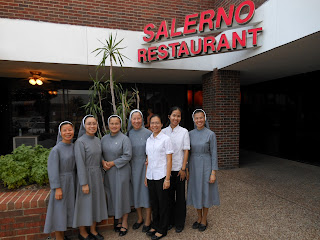Cauliflowers in the Convent

Cooking is one of the many skills in the repertoire of a sister’s training, that is a Trinh Vuong sister’s training.
With this aim in mind, Sr. Irene, the aspirancy director sent Nhung to the garage one beautiful spring afternoon.
Who is Nhung? She is an aspirant, which means she is a young woman who is in her first 12-24 months of entrance into the convent.
Her mission? Stir-fry cauliflower for dinner.
Why the garage? As all Vietnamese knows, good cooking requires fish sauce. And all great Vietnamese-American chefs do not cook in the main part of the house for fear of the fish sauce.
One hour later with evening prayer approaching, Sr. Irene began to wonder why Nhung has not re-appeared. She headed for the garage and found Nhung diligently stirring and peering into the pan.
“Sister, I just don’t understand why this cauliflower still looks like this!” Nhung exclaimed in exasperation.
Sr. Irene took one look at the cauliflower and pinched herself hard to keep from laughing out loud.
“I’ve been turning it over and over… and it won’t break apart!” Nhung continued forlornly.
“You put the whole head into the pot?” Sr. Irene whispered hoarsely.
“Isn’t that what you’re supposed to do?” Nhung replied. “Doesn’t the heat makes the cauliflower break apart into little pieces…???”
“Oh Nhung! It’s not the heat that cut the cauliflower into pieces. It’s a knife.”
And so I’ve shared with you a little secret on how sisters stay so young. We cannot stop laughing! There is no end to humorous tales in the convent life, especially when it touches the kitchen… or the chapel. Of course, to protect her identity, “Nhung” is not her real name.
Fun facts about cauliflower:
1. If you wish to stir-fry cauliflower, you have to cut it up before putting it into the pan.
2. The cauliflower is actually a flower. The part that we eat is the head of the underdeveloped, tender flower stems and buds.*
3. The cauliflower is related to the cabbage and broccoli. Their four-petaled flowers bear the resemblance to a Greek cross, which explains why they are frequently referred to as crucifers or cruciferous vegetables.**
* http://www.dole.com/SuperKids/Encyclopedia/Facts/tabid/831/Default.aspx?contentid=2513
** http://www.dole.com/SuperKids/Encyclopedia/Facts/tabid/831/Default.aspx?contentid=2513



Comments
Post a Comment